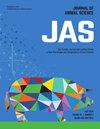Effect of undigestible neutral detergent fiber concentration in finishing diets containing dry-rolled or steam-rolled barley for feedlot steers
IF 2.7
2区 农林科学
Q1 AGRICULTURE, DAIRY & ANIMAL SCIENCE
引用次数: 0
Abstract
This study evaluated the impact of grain processing method (dry- vs. steam-rolling) and diet uNDF concentration (low vs. high; 5.7% vs. 6.6% on DM basis by replacing silage with straw) in finishing diets on feed intake, feeding behavior, growth performance, ruminal pH, fermentation parameters, inflammatory stress responses, and carcass traits of 376 intact (initial BW ± SD, 440 ± 33.6 kg), and 24 ruminally cannulated steers (initial BW ± SD, 474 ± 30.5 kg). Steers were housed in 32 pens with 4 pens of 30 steers, and 28 pens of 10 steers. Eight of the pens with 10 steers, and all of the pens with 30 steers were equipped with GrowSafe® to record individual feed intake and feeding behavior. Three cannulated and 7 intact steers were housed in the smaller GrowSafe® pens. Diets included: 1) dry-rolled barley and barley silage; 2) dry-rolled barley and barley straw; 3) steam-rolled barley and barley silage; and 4) steam-rolled barley and barley straw, formulated to contain 89% barley-grain, 6% roughage and 5% vitamin and mineral supplement (DM basis). Interactions between processing method and uNDF concentration were observed for maximum ruminal pH, and concentrations of blood glucose and lipopolysaccharide binding proteins. Compared to dry-rolling, steam-rolling did not improve growth performance, ruminal pH, fermentation parameters, or liver abscess scores, but did increase longissimus muscle (LM) area (P = 0.01) and decrease the proportion of AAA carcasses (P = 0.01). Steam-rolled barley decreased (P = 0.04) glucose and increased (P = 0.01) blood concentrations of insulin and acute phase proteins. Increasing uNDF did not affect feed intake, growth, carcass traits, or liver abscess scores, but did increase (P = 0.01) bunk attendance, meal duration, and to a lesser extent meal intervals (P = 0.04) and eating rate (P = 0.01). Increased uNDF raised (P = 0.04) mean ruminal pH and reduced the duration of pH below 6.0, 5.8 and 5.2, and tended (P = 0.06) to increase the acetate to propionate ratio. The lack of growth response to dietary uNDF concentration could be due to the small differences in uNDF intake, or that uNDF concentration was sufficient to prevent digestive disturbances. Increasing dietary uNDF altered eating behavior and ruminal pH in a manner that could reduce the risk of clinical and subclinical ruminal acidosis.含有干轧制或蒸轧制大麦的育成日粮中不可消化中性洗涤纤维浓度对饲养肉牛的影响
本研究评估了谷物加工方式(干法vs蒸制)和日粮uNDF浓度(低vs高;对376头完整阉牛(初始体重±SD, 440±33.6 kg)和24头瘤胃空心阉牛(初始体重±SD, 474±30.5 kg)的采食量、摄食行为、生长性能、瘤胃pH、发酵参数、炎症应激反应和胴体性状的影响(5.7% vs. 6.6%,以秸秆替代青贮)。牛被饲养在32个栏中,其中4个栏每30头牛,28个栏每10头牛。8个有10头牛的猪圈和所有30头牛的猪圈都配备了GrowSafe®,以记录个体采食量和摄食行为。3头空心阉牛和7头完整阉牛被安置在较小的GrowSafe®围栏中。饲粮包括:1)干卷大麦和青贮大麦;2)干卷大麦和大麦秸秆;3)蒸熟大麦和青贮大麦;4)蒸轧大麦和大麦秸秆,配方中含有89%的大麦,6%的粗饲料和5%的维生素和矿物质补充剂(DM基础)。观察加工方式与uNDF浓度之间的相互作用,影响最大瘤胃pH、血糖和脂多糖结合蛋白浓度。与干滚相比,蒸滚对生长性能、瘤胃pH、发酵参数和肝脓肿评分没有显著改善,但增加了最长肌(LM)面积(P = 0.01),降低了AAA胴体比例(P = 0.01)。蒸熟大麦降低血糖(P = 0.04),升高胰岛素和急性期蛋白浓度(P = 0.01)。增加uNDF不影响采食量、生长、胴体性状或肝脓肿评分,但确实增加了上铺率(P = 0.01)、采食时间,在较小程度上增加了采食间隔(P = 0.04)和采食率(P = 0.01)。增加uNDF提高了瘤胃平均pH (P = 0.04),缩短了pH低于6.0、5.8和5.2的持续时间,并有增加乙酸丙酸比的趋势(P = 0.06)。对饮食中uNDF浓度缺乏生长反应可能是由于uNDF摄入量差异不大,或者uNDF浓度足以防止消化紊乱。增加日粮uNDF改变了饮食行为和瘤胃pH值,从而降低了临床和亚临床瘤胃酸中毒的风险。
本文章由计算机程序翻译,如有差异,请以英文原文为准。
求助全文
约1分钟内获得全文
求助全文
来源期刊

Journal of animal science
农林科学-奶制品与动物科学
CiteScore
4.80
自引率
12.10%
发文量
1589
审稿时长
3 months
期刊介绍:
The Journal of Animal Science (JAS) is the premier journal for animal science and serves as the leading source of new knowledge and perspective in this area. JAS publishes more than 500 fully reviewed research articles, invited reviews, technical notes, and letters to the editor each year.
Articles published in JAS encompass a broad range of research topics in animal production and fundamental aspects of genetics, nutrition, physiology, and preparation and utilization of animal products. Articles typically report research with beef cattle, companion animals, goats, horses, pigs, and sheep; however, studies involving other farm animals, aquatic and wildlife species, and laboratory animal species that address fundamental questions related to livestock and companion animal biology will be considered for publication.
 求助内容:
求助内容: 应助结果提醒方式:
应助结果提醒方式:


